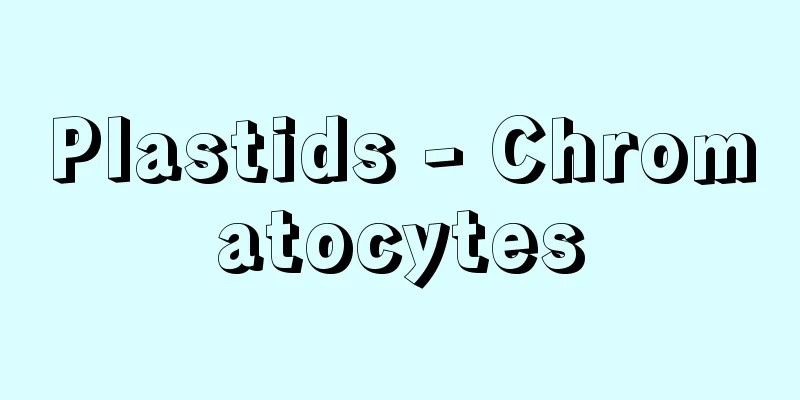Plastids - Chromatocytes

|
A structure unique to eukaryotic cells that perform photosynthesis, also known as a plastid, is made up of two unit membranes, an inner and an outer one. Based on their morphological and functional characteristics, they are classified into chloroplasts, xanthoplasts, etioplasts, proplastids, leucoplasts, etc. Chloroplasts are the plastids of cells that perform photosynthesis using chlorophyll; those that contain phycoxanthin in addition to chlorophyll are sometimes called brown bodies, and those that contain phycoerythrin are sometimes called red bodies. In all cases, the thylakoids formed from the inner membrane are very well developed. In addition to chlorophyll, chloroplasts contain carotenoids as auxiliary pigments, but when chlorophyll is not synthesized or is broken down for some reason, and the color of the carotenoids stands out, they are called yellow bodies. Since they lack chlorophyll, they do not carry out photosynthesis, and their thylakoids have almost completely disappeared. Yellow bodies are found in the cells of prominent yellow or reddish-orange tissues in fruits and petals. In the past, yellow bodies were sometimes called chromoplasts or polychromoplasts. Ethioplasts are plastids (bean sprouts are a good example) of cells that would normally turn green when exposed to light, but because they are not exposed to light, chlorophyll synthesis does not occur and they remain white. The membrane components that would normally become thylakoids have become a mass of thin tubes (prolamellar bodies). However, when exposed to light, chlorophyll is rapidly formed and the thylakoids develop, becoming normal chloroplasts. Proplastids are plastids that do not contain chlorophyll and are found in actively dividing cells. They are small in size and have poorly developed thylakoids, and they divide repeatedly. They also contain small amounts of carotenoids. These plastids have the potential to become chloroplasts when given certain hormones or light. They synthesize starch and assimilate nitrogen. Leucoplasts are very similar to proplastids, but they do not contain carotenoids and are plastids that have lost the ability to become chloroplasts at the genetic level, and will not become chloroplasts even when exposed to hormones or light. They synthesize starch and assimilate nitrogen, and are found inside roots and stems. These plastids, like mitochondria, have a small number of genes separate from the nucleus and are capable of synthesizing proteins independently. [Sato Shichiro] Source: Shogakukan Encyclopedia Nipponica About Encyclopedia Nipponica Information | Legend |
|
光合成を行う真核生物の細胞に特有の構造体で、プラスチドplastidともいい、内外2枚の単位膜からできている。その形態上、機能上の特徴から葉緑体、黄色体、エチオプラスト、プロプラスチド、白色体などに分けられる。葉緑体はクロロフィルをもって光合成を行っている細胞の色素体で、クロロフィルのほかにフィコキサンチンをもっているものは褐色体、フィコエリスリンをもっているものは紅色体とよばれることもある。いずれも内側の膜から形成されたチラコイドがたいへんよく発達している。 葉緑体はクロロフィルのほか、補助色素としてカロチノイドを含んでいるが、なんらかの原因でクロロフィルが合成されず、あるいは分解されて、カロチノイドの色が目だつようになっているものを黄色体という。これはクロロフィルがないために光合成を行わず、チラコイドもほとんど消失している。黄色体は果実や花びらの黄色ないし赤橙(せきとう)色の目だつ組織の細胞に含まれている。黄色体は古くは有色体あるいは雑色体などとよばれたこともある。 エチオプラストは、本来は光が当たって緑色になるはずのものが、光が当たらないためにクロロフィルの合成がおこらず、白色の状態にとどまっている細胞の色素体(もやしが好例)である。正常ならチラコイドになるはずの膜成分は細い管の塊(プロラメラ・ボディ)となっている。しかし、光が当たると急速にクロロフィルが形成されるとともにチラコイドが発達し、正常な葉緑体となる。 プロプラスチドは、盛んに分裂を行っている細胞に含まれるクロロフィルをもたない色素体で、形が小さく、またチラコイドの発達が悪く、これ自体分裂を繰り返している。なお、少量のカロチノイドをもっている。この色素体はある種のホルモンや光が与えられると葉緑体になる可能性をもっている。デンプンの合成と窒素同化の作用がある。 白色体はプロプラスチドとよく似ているが、カロチノイドをもたず、遺伝子レベルで葉緑体になる能力を失った色素体で、ホルモンや光を与えても葉緑体にはならない。デンプン合成と窒素同化を行っており、根や茎の内部などにみられる。これらの色素体は、ミトコンドリアと並んで少量ながら核とは別の遺伝子をもち、独自にタンパク質の合成を行う能力をもっている。 [佐藤七郎] 出典 小学館 日本大百科全書(ニッポニカ)日本大百科全書(ニッポニカ)について 情報 | 凡例 |
Recommend
Roman de Troie (English spelling) RomandeTroie
…from Touraine. He wrote the long verse Roman de ...
Chuya Marubashi
A ronin (masterless samurai) from the Edo period....
Metal oxide semiconductor diode
...A diode (Figure 1) that is constructed by form...
Theme
The subject is the central subject of a research ...
Ateru - Ateru
…Wrestling is said to be the oldest sport in the ...
Moon Viewing
〘 noun 〙 Admiring the moon. Moon viewing. It is of...
Reason for discussion - Giko
〘 noun 〙 One of the six principles in the Ritsuryo...
Response Displacement Method
… Around 1970, the earthquake resistance of under...
Onigadake - Onigadake
(Echizen City, Fukui Prefecture) A tourist attract...
Song Yuan coins
Copper coins minted in the Song (960-1279) and Yua...
Isopropyl
…There are two structural isomers: CH 3 CH 2 CH 2...
UMA - UMA
Upper Memory AreaMemory area from 640KB to 1MB def...
Pindemonte, Ippolito
Born: November 13, 1753, Verona [Died] November 18...
temperament - temperament
A group of Ukiyo-zoshi (idiomatic stories about t...
Rosette (English spelling)
(1) A term in plant morphology. It refers to a mor...









![Omaezaki [town] - Omaezaki](/upload/images/67cb226dcb516.webp)